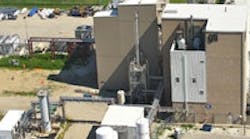PILOT PLANT SITE
Figure 1. A pilot plant at Gas Technology Institute’s advanced gasification test facility processes renewable gasoline from woody biomass. Source: Gas Technology Institute.
The project started in 2010 with the construction of the biorefinery at GTI’s gasification testing complex in Des Plaines, Ill. Commissioning was completed in late 2012 and full-scale testing began in March 2013. “Over the past four years, we’ve demonstrated an economically viable method for thermochemical conversion of woody biomass into gasoline. We’re extremely pleased with the positive results and the potential to meet growing energy needs with cost-effective and clean renewable resources,” says Rick Knight, GTI institute engineer and manager of the installation, integration and operational testing at GTI.The goal was to process about 20 tons of pellets per day to produce up to 22.5 barrels of “green” gasoline. The entire thermochemical process has been designed to be extremely energy efficient with very little waste, adds Knight.First, a GTI-based Andritz-Carbona biomass gasifier turns wood into syngas. From there, a reforming process jointly developed by Andritz-Carbona and Haldor Topsoe cleans the syngas of tars and other contaminants. Then, GTI’s Morphysorb solvent removes carbon dioxide and sulfur gases in an acid gas removal (AGR) pilot unit. For the last step, Haldor Topsoe’s improved gasoline synthesis (TIGAS) process integrates methanol/dimethylether (DME) synthesis and the subsequent conversion into gasoline in a single synthesis loop. The methanol/DME synthesis is very flexible, and can handle a variety of synthesis gas compositions.Andritz Carbona and Pall Corporation supplied some equipment and run-time assistance. Pulp and paper company UPM provided the wood feedstock, and Phillips 66 assisted with design, provided on-site consultation, supervised fuel testing, and arranged fleet testing.In October 2013, the team produced about 4,000 gallons of gasoline suitable as a blendstock for conventional gasoline. This was used for single-engine emissions testing, demonstrating that renewable gasoline would meet EPA standards in blends up to 80%.As of March 2014, the biorefinery has produced sufficient quantities for testing to prove the gasoline can be used in existing automobile engines. Around 7,770 gallons have been sent to a blending facility in Michigan to prepare it for fleet testing at the Transportation Research Center in East Liberty, Ohio. Four pairs of vehicles will each log 75,000 miles comparing performance of a 50% bio-based gasoline blend with conventional gasoline. Results will be available next month.“For the first time, all the individual steps are now integrated into one plant to produce transportation fuel. In the future, biomass may be a significant feedstock source and the combination of technologies demonstrated in this project will be part of the solution to the future fuel supply,” notes Niels Udengaard, syngas technology manager and overall project lead, Haldor Topsoe.“The right partnership is critical to deliver successful high-impact results. This is a prime example of an effective team that brings together public and private sectors with the combined technical expertise, facilities and funding required to transition technologies into proven integrated processes,” says Vann Bush, GTI managing director, energy conversion. “We are creating biofuels from renewable resources that help to keep our environment clean and convert lower-value resources into high-value products.”The process is now ready to be scaled up to a commercial-sized production plant, but challenges remain. Building a commercial plant will cost an estimated $750 million. “To make that type of investment, the private industry needs some assurance of what the government policies are going to be in 10 years, 15 years, 20 years, says Jim Patel, president of Andritz-Carbona Corporation. “So that’s one of the things that has to be overcome” before the process can be scaled up to commercial level, he adds.


